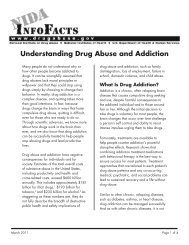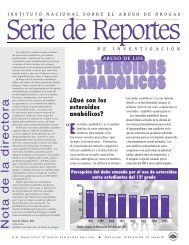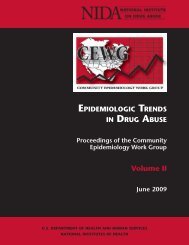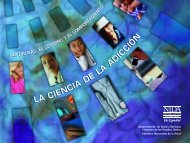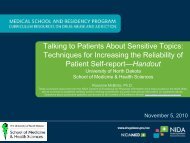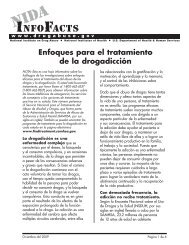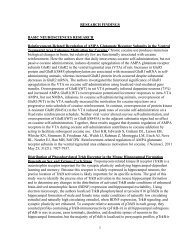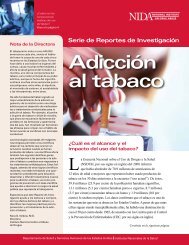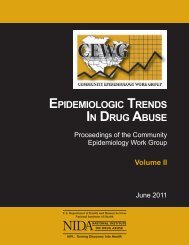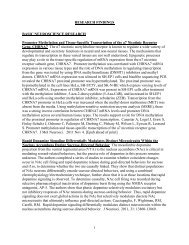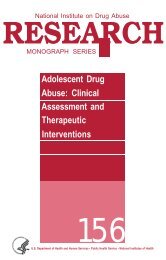CEWG January 09 Full Report - National Institute on Drug Abuse
CEWG January 09 Full Report - National Institute on Drug Abuse
CEWG January 09 Full Report - National Institute on Drug Abuse
Create successful ePaper yourself
Turn your PDF publications into a flip-book with our unique Google optimized e-Paper software.
EpidEmiologic TrEnds in drug AbusE: HigHligHTs And ExEcuTivE summAry<br />
Heroin<br />
• Heroin primary treatment admissi<strong>on</strong>s, as a percentage of total admissi<strong>on</strong>s, including primary<br />
alcohol admissi<strong>on</strong>s, were particularly high in Baltimore City (approximately 55 percent), followed<br />
by Bost<strong>on</strong> (approximately 48 percent) in the first half of 2008 (appendix table 1; secti<strong>on</strong> II, table<br />
2; table 4 below). In Bost<strong>on</strong>, Baltimore City, and Detroit, heroin primary admissi<strong>on</strong>s ranked first as<br />
the most frequent substance abuse admissi<strong>on</strong>s in the reporting period (secti<strong>on</strong> II, table 2).<br />
• In 16 of 22 <str<strong>on</strong>g>CEWG</str<strong>on</strong>g> areas, heroin items accounted for less than 10 percent of total drug items<br />
identified in NFLIS forensic laboratories in the first half of 2008. Proporti<strong>on</strong>s were highest in<br />
Baltimore City and Maryland (approximately 22 and 20 percent, respectively). They were lowest<br />
in Texas and Atlanta, at approximately 2 percent of drug items identified (figure 16; appendix<br />
table 2). Heroin was not ranked first in drug items seized in any <str<strong>on</strong>g>CEWG</str<strong>on</strong>g> area (secti<strong>on</strong> II, table 1).<br />
• According to the DEA’s HDMP, in CY 2007, South American (SA) heroin c<strong>on</strong>tinued to be the<br />
primary source of heroin east of the Mississippi River, as has been the case since the mid-1990s,<br />
while Mexican black tar and, to a lesser extent, Mexican brown powder heroin dominated<br />
markets west of the Mississippi (figure 17).<br />
• From 2006 to 2007, average purity levels for SA heroin increased in 6 of 10 <str<strong>on</strong>g>CEWG</str<strong>on</strong>g> areas<br />
(Philadelphia, New York City, Detroit, Chicago, St. Louis, and Washingt<strong>on</strong>, DC), in c<strong>on</strong>trast to<br />
2005–2006, when purity levels remained stable or declined in most areas (table 5).<br />
• Over the 1-year period from 2006 to 2007, average prices for SA heroin fell in 6 of 10 <str<strong>on</strong>g>CEWG</str<strong>on</strong>g> areas<br />
(Atlanta, Miami, Bost<strong>on</strong>, Chicago, St. Louis, and Washingt<strong>on</strong>, DC) and rose in 4 (Philadelphia, New<br />
York City, Baltimore, and Detroit). From 2006 to 2007, the highest unit increase was for Detroit<br />
($0.22), while the highest unit decrease was for Atlanta ($0.45) (table 5).<br />
• From 2006 to 2007, Mexican heroin average purity declined in five <str<strong>on</strong>g>CEWG</str<strong>on</strong>g> areas (San Diego, El<br />
Paso, San Ant<strong>on</strong>io, Houst<strong>on</strong>, and San Francisco). Average purity increased in four areas (Seattle,<br />
Phoenix, Denver, and Dallas), and remained c<strong>on</strong>stant in <strong>on</strong>e area (Los Angeles). The average price<br />
was lower or the same in 2007, compared with 2006, in 7 of 10 reporting <str<strong>on</strong>g>CEWG</str<strong>on</strong>g> areas, namely<br />
Seattle, Phoenix, Denver, San Diego, Los Angeles, Dallas, and Houst<strong>on</strong>. It was higher in El Paso,<br />
San Ant<strong>on</strong>io, and San Francisco (table 6).<br />
Treatment Admissi<strong>on</strong> Data <strong>on</strong> Heroin<br />
In this reporting period (the first half of 2008) for<br />
18 of 22 <str<strong>on</strong>g>CEWG</str<strong>on</strong>g> areas, primary heroin treatment<br />
admissi<strong>on</strong>s, as a proporti<strong>on</strong> of total admissi<strong>on</strong>s<br />
for substance abuse treatment, including primary<br />
alcohol admissi<strong>on</strong>s, ranged from approximately<br />
2 percent in Hawai‘i to approximately 55 percent<br />
in Baltimore City. After Baltimore City, Bost<strong>on</strong><br />
had the highest proporti<strong>on</strong> of heroin admissi<strong>on</strong>s,<br />
at 48.3 percent of all admissi<strong>on</strong>s (table 4). The<br />
lowest percentage of primary heroin admissi<strong>on</strong>s,<br />
after Hawai‘i (2.3 percent), was in Miami/Dade<br />
County (3.6 percent).<br />
When all admissi<strong>on</strong>s, including those for<br />
whom alcohol was the primary drug, are examined,<br />
heroin ranked first in Bost<strong>on</strong>, Baltimore<br />
City, and Detroit, and sec<strong>on</strong>d in New York City<br />
and Maryland (secti<strong>on</strong> II, table 2).<br />
Forensic Laboratory Data <strong>on</strong> Heroin<br />
In 16 of the 22 <str<strong>on</strong>g>CEWG</str<strong>on</strong>g> areas shown <strong>on</strong> the map<br />
in figure 12 (secti<strong>on</strong> II), heroin items accounted<br />
for less than 10 percent of the total drug items<br />
reported by NFLIS. The excepti<strong>on</strong>s were New<br />
York City, Philadelphia, Chicago, Baltimore City,<br />
and Maryland. As a proporti<strong>on</strong> of total drug items,<br />
78<br />
Proceedings of the Community Epidemiology Work Group, <str<strong>on</strong>g>January</str<strong>on</strong>g> 20<str<strong>on</strong>g>09</str<strong>on</strong>g>



